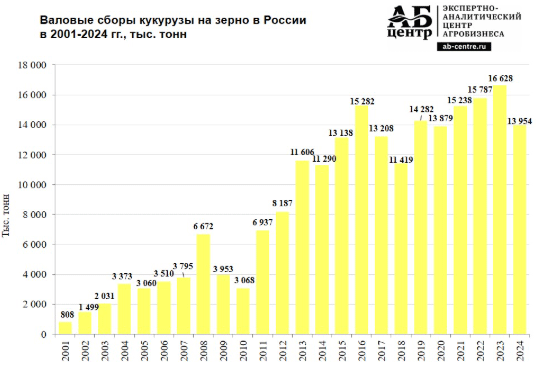Russia’s 2024 Corn Production Hit by Yield Collapse: Key Insights for Farmers and Agronomists
According to revised data from Rosstat and analysis by AB-Center, Russia harvested 13.95 million tons of corn for grain in 2024, down 2.67 million tons (–16.1%) compared to 2023. This significant reduction came despite an increase in planting area by 1.1%, reaching 2.7 million hectares.
The key driver behind this decline? A sharp drop in yield per hectare. In 2024, the average yield fell by over 25%, reaching just 5.19 tons/ha (51.9 centners/ha). This is well below both historical Russian averages and international benchmarks.
Yield Pressures Reflect Broader Trends
Russia’s corn yield setback mirrors wider issues seen in global agriculture in 2024. According to the Food and Agriculture Organization (FAO) and World Meteorological Organization, erratic weather, including extended droughts, flooding, and heatwaves, disrupted yields in many major producing regions. In Russia, unseasonably dry conditions during critical growth phases in the Southern and Central regions were cited as a major factor.
Russia’s top corn-producing regions in 2024 included:
- Krasnodar Krai
- Kursk Region
- Voronezh Region
- Bryansk Region
- Tambov Region
Together, these five regions accounted for 38.6% of the country’s total corn harvest. Corn was also grown in significant volumes (100,000+ tons) in 25 regions, showing the crop’s widespread role in Russian agriculture.
While Russia’s corn sector has been growing steadily over the past decade — with expanded hybrid use, better seed quality, and improved mechanization — 2024 marks a setback that underlines the importance of resilience in crop management.
A Wake-Up Call for Smarter, Climate-Adapted Corn Production
The 2024 drop in Russian corn output is a clear reminder that expanding acreage alone is not enough — productivity per hectare is what truly drives profitability and national food security. Moving forward, agricultural stakeholders will need to focus on:
- Drought-resistant hybrids
- Improved agronomic practices
- Real-time weather-informed decision making
- Efficient irrigation and soil fertility management
For scientists, agronomists, and farmers, the lesson is clear: boosting resilience and yield stability must take priority as climate volatility becomes the new normal.
Error





